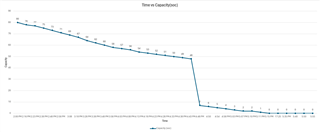Other Parts Discussed in Thread: BQSTUDIO, GAUGEPARCAL, AM62A7
Hello TI,
I am successfully able to updated the Design Capacity of bq27220 from 3000mAh to 9000mAh but the FCC "Charge Full" parameter is still 3000mAh.
One of your posts say that the FCC can not be updated manually, but learn with charging discharging cycle.
whereas the https://e2e.ti.com/support/power-management-group/power-management/f/power-management-forum/641728/bq27220-simple-step-to-update-bq27220-fcc-value post suggest that I need to update Learned Full Charge Capacity and Qmax Pack in data memory. But don't know how to update these registers.
I don't have EVM board to cross verify the FCC parameter on BqStudio.
Please Guide.










